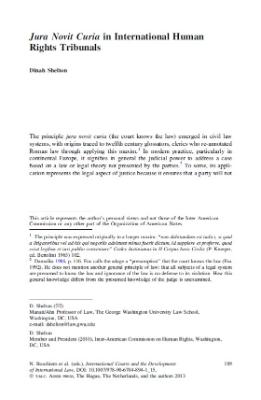
|
Jura Novit Curia in International Human Rights Tribunals
Human rights bodies have been created to monitor compliance by states parties with the rights and obligations contained in their respective treaties. Such bodies generally have similar mandates to review periodic state reports, undertake inquiries, issue general comments or recommendations, and hear (optionally) complaints or communications by those persons claiming their rights were violated. This essay examines the juridical value of the resulting pronouncements made by the different human rights bodies. It examines the development over time of the practice of treaty bodies and pronouncements they themselves have made about the juridical value of their decisions, comments, and views. The conclusion undertakes an assessment of the notion of authoritativeness and the degree of deference owed by states to the pronouncements of human rights treaty bodies. The study indicates that the ambivalent, often reticent attitude of governments towards human rights law—revealed in the deliberately limited powers of treaty bodies—has failed to halt the creative development of procedures that allow for normative evolution and genuine scrutiny of compliance by states parties. The expansion of juridical status for the determinations of human rights bodies reflects the fact that effective promotion and protection of internationally guaranteed human rights requires a degree of international accountability, even if the role of international bodies is subsidiary to national implementation.
|
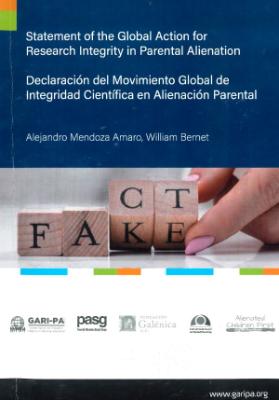
|
Declaración del movimiento global de integridad científica en alienación parental
Esta declaración, es un estudio técnico-científico altamente especializado en materia de integridad científica en alienación parental, donde se utilizan los documentos más importantes en el campo como los de la Cátedra de Bioética de la Organización de las Naciones Unidas para la Educación, la Ciencia y la Cultura. Así mismo, este estudio analiza y da a conocer las consecuencias negativas a este tipo de maltrato infantil, tales como: estigma, difamación, calumnia e injuria, campañas de desinformación "científica", censura, entre otros.
|
|
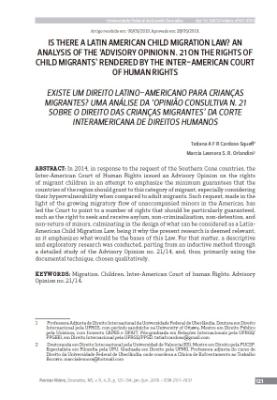
|
Is there a latin american child migration law? An analysis of the ‘Advisory Opinion N. 21 on the rights of child migrants’ rendered by the Inter-American Court of Human Rights
In 2014, in response to the request of the Southern Cone countries, the Inter-American Court of Human Rights issued an Advisory Opinion on the rights of migrant children in an attempt to emphasize the minimum guarantees that the countries of the region should grant to this category of migrant, especially considering their hypervulnerability when compared to adult migrants. Such request, made in the light of the growing migratory flow of unaccompanied minors in the Americas, has led the Court to point to a number of rights that should be particularly guaranteed, such as the right to seek and receive asylum, non-criminalization, non-detention, and non-return of minors, culminating in the design of what can be considered as a Latin-American Child Migration Law, being it why the present research is deemed relevant, as it emphasizes what would be the bases of this Law. For that matter, a descriptive and exploratory research was conducted, parting from an inductive method through a detailed study of the Advisory Opinion no. 21/14, and, thus, primarily using the documental technique, chosen qualitatively.
|
|
|
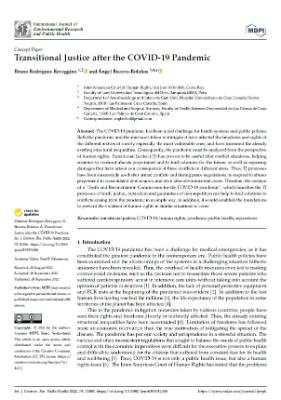
|
Transitional Justice after the COVID-19 Pandemic
The COVID-19 pandemic has been a real challenge for health systems and public policies. Both the pandemic and the measures taken to mitigate it have affected the freedoms and rights of the different sectors of society, especially the most vulnerable ones, and have increased the already existing structural inequalities. Consequently, the pandemic must be analyzed from the perspective of human rights. Transitional Justice (TJ) has proven to be useful after conflict situations, helping societies to confront abuses perpetrated and to find solutions for the future, as well as repairing damages that have arisen as a consequence of these conflicts in different areas. Thus, TJ processes have been successfully used after armed conflicts and during peace negotiations, to respond to abuses perpetrated in consolidated democracies, and even after environmental crises. Therefore, the creation of a “Truth and Reconciliation Commission for the COVID-19 pandemic”, which launches the TJ processes of truth, justice, reparation and guarantees of non-repetition can help to find solutions to conflicts arising from the pandemic in a simple way. In addition, it would establish the foundations to prevent the violation of human rights in similar situations to come.
|
|
|
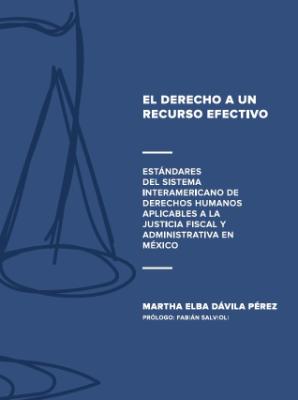
|
El derecho a un recurso efectivo: Estándares del Sistema Interamericano de Derechos Humanos aplicables a la justicia fiscal y administrativa en México
Dividido en siete capítulos los dos primeros introducen nociones generales y básicas del derecho internacional de los derechos humanos, explicando los sistemas dentro de Naciones Unidas y regionales, para focalizar luego en el sistema regional americano y las competencias de sus órganos. El capítulo tercero, analiza críticamente la participación de México en el sistema de la OEA. El capítulo cuarto visibiliza al derecho al recurso efectivo como un mecanismo imprescindible a los efectos de controlar adecuadamente, y en perspectiva de derechos humanos. El capítulo quinto es, a mi juicio, el más rico del libro: allí se muestra un sólido bagaje teórico al concepto de “recurso efectivo”, partiendo de las obligaciones surgidas de la ratificación o adhesión a instrumentos convencionales internacionales de derechos humanos, y los deberes generales que surgen de las normas iniciales contenidas en los mismos. El capítulo sexto describe las características del derecho al recurso efectivo, además de la eficacia, viabilidad, rapidez y sencillez como requisitos para su adecuado funcionamiento El capítulo séptimo, finalmente, entra en el alambicado terreno del juicio contencioso administrativo federal en México, explicándolo con claridad y pedagogía, para ingresar en el necesario test de convencionalidad de la actuación de dicho fuero.
|
|
|
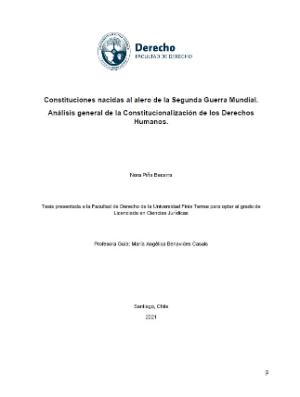
|
Constituciones nacidas al alero de la Segunda Guerra Mundial: Análisis general de la Constitucionalización de los Derechos Humanos
Nótese que existen juristas que niegan o restan validez a los Derechos Humanos como elementos constitucionalizados a partir de la comunidad internacional, esgrimiendo críticas sobre la naturaleza de estos con relación al derecho constitucional y su categorización como derechos fundamentales. Dicho esto, nos haremos cargo en primer lugar de dilucidar los planteamientos centrales entorno a esta discusión y mostrar que los Derechos Humanos se pueden contener en las constituciones contemporáneas como derechos fundamentales o constitucionales. En segundo lugar, se abordarán en esta investigación los debates centrales entorno a la concepción de constitucionalización, para referir posteriormente a las vertientes que agrupan el estudio de este fenómeno jurídico, para así identificar los aspectos significativos en el contexto histórico que permiten probar y la existencia de este proceso. Tras lograr lo anterior, se identificará el vínculo jurídico contenido en los tratados, capitulaciones o instrumentos internacionales celebrados que permiten sostener que la constitucionalización de los derechos humanos fue un proceso promovido por fuerzas de ocupación extranjeras las cuales influyeron en los respectivos procesos constituyentes.
|
|
|
|
|